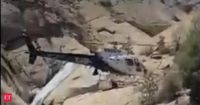Ryan Wardwell, a 46-year-old climber from Long Beach, California, experienced a harrowing ordeal in the rugged wilderness of Sequoia National Forest, spending two days trapped behind a waterfall before being rescued in a dramatic operation involving multiple agencies and cutting-edge technology. The incident, which unfolded in early August 2025, has captured widespread attention and highlighted both the dangers of outdoor adventure and the dedication of search and rescue teams in California.
According to CBS News, Wardwell set out for a solo climbing expedition in Sequoia National Forest on August 10, 2025. When he failed to return to his car that evening, concern quickly mounted. Friends and family, aware of his plans and the challenging terrain he faced, alerted authorities. The Tulare County Sheriff’s Office soon launched a search and rescue effort, mobilizing resources to cover the vast and treacherous landscape.
Law enforcement moved swiftly, deploying infrared technology and aircraft to scan the forested area. However, the combination of rough terrain and the late hour forced officials to suspend the search on the first night. The forest’s steep canyons, dense foliage, and unpredictable water flows made every hour critical, especially as temperatures dropped and the risk of hypothermia increased. The pressure was mounting—not just for Wardwell’s loved ones, but for the rescue teams who knew how quickly conditions could worsen.
As reported by The Economic Times, a breakthrough came during the early hours of August 12, 2025. A specialized dive and rescue team, equipped with a drone, managed to pinpoint Wardwell’s location behind a large waterfall. The use of drone technology was a game-changer in this search, allowing rescuers to access visual information in areas that were otherwise inaccessible on foot or by air. The Tulare County Sheriff’s Office later posted a video of the rescue to Facebook, offering a glimpse into the tense and complex operation.
Wardwell’s predicament was the result of a sudden and dangerous turn of events. According to police officials, he had come off his rappelling lines when “the extreme hydraulics of the river” trapped him behind the cascade. The force of the water, combined with the slick surfaces and limited visibility, created a situation where escape was impossible without outside help. For two days, Wardwell remained trapped—alive, but in a perilous position, as the constant roar of the waterfall and the chill of the mist sapped his strength.
Fox News reported on August 16, 2025, that Wardwell was ultimately rescued by a California Highway Patrol helicopter. The helicopter crew, working in coordination with ground teams, executed a precision maneuver to reach the spot where Wardwell was stranded. The rescue required not just technical skill, but also careful timing, as the conditions around the waterfall remained hazardous. When Wardwell was finally brought to safety, he was found to be alive and responsive—a testament to his resilience and the effectiveness of the rescue operation.
The story of Wardwell’s ordeal and rescue quickly spread across news outlets, with many highlighting the role of technology and inter-agency cooperation. According to The Economic Times, the rescue involved the use of infrared imaging, drones, and aerial reconnaissance, demonstrating how modern tools are reshaping the way search and rescue missions are conducted in remote and dangerous environments. The Tulare County Sheriff’s Office, California Highway Patrol, and specialized dive teams all played critical roles in the successful outcome.
For those familiar with the risks of outdoor adventure, Wardwell’s experience serves as a stark reminder of how quickly things can go wrong—even for experienced climbers. The Sequoia National Forest, with its dramatic waterfalls and rugged terrain, is a magnet for thrill-seekers, but it also demands respect and preparation. The incident has prompted renewed discussion about safety protocols, the importance of notifying others of one’s plans, and the value of carrying emergency communication devices.
Yet, Wardwell’s survival is also a story of hope and human ingenuity. The rapid mobilization of search and rescue teams, the willingness of volunteers to brave difficult conditions, and the integration of new technologies all contributed to a positive outcome. In a video posted by the Tulare County Sheriff’s Office, rescuers can be seen working methodically to reach Wardwell, their focus unwavering even as water thundered down around them. The footage, which quickly garnered thousands of views, resonated with viewers who saw in it a powerful example of community and determination.
As the details of the rescue emerged, officials provided further insight into the challenges they faced. The use of infrared technology allowed searchers to detect heat signatures in the cold, dark forest, while drones provided aerial views of areas that would have taken hours to reach on foot. The California Highway Patrol helicopter, equipped for mountain rescues, was able to hover above the waterfall and lower rescuers to Wardwell’s position. Each step of the operation required careful coordination, clear communication, and a willingness to adapt to rapidly changing conditions.
Wardwell’s recovery is ongoing, but authorities have confirmed that he was responsive and in stable condition following his rescue. The climber has not yet spoken publicly about his experience, but those involved in the operation have praised his endurance and calm under pressure. “The extreme hydraulics of the river trapped him behind the cascade,” police officials explained, underscoring the unpredictable nature of the environment Wardwell faced.
The incident has also sparked conversations about the future of search and rescue operations in California and beyond. With more people seeking adventure in remote areas, the demand for advanced technology and specialized training is expected to grow. Agencies are increasingly investing in drones, thermal imaging, and other tools that can make the difference between life and death in critical situations. The rescue of Ryan Wardwell stands as a vivid example of what can be achieved when innovation, expertise, and human compassion come together.
For now, the focus remains on Wardwell’s recovery and the lessons that can be drawn from his ordeal. The story has become a touchstone for outdoor enthusiasts, emergency responders, and all those who marvel at the power of nature—and the resilience of the human spirit when faced with overwhelming odds.





